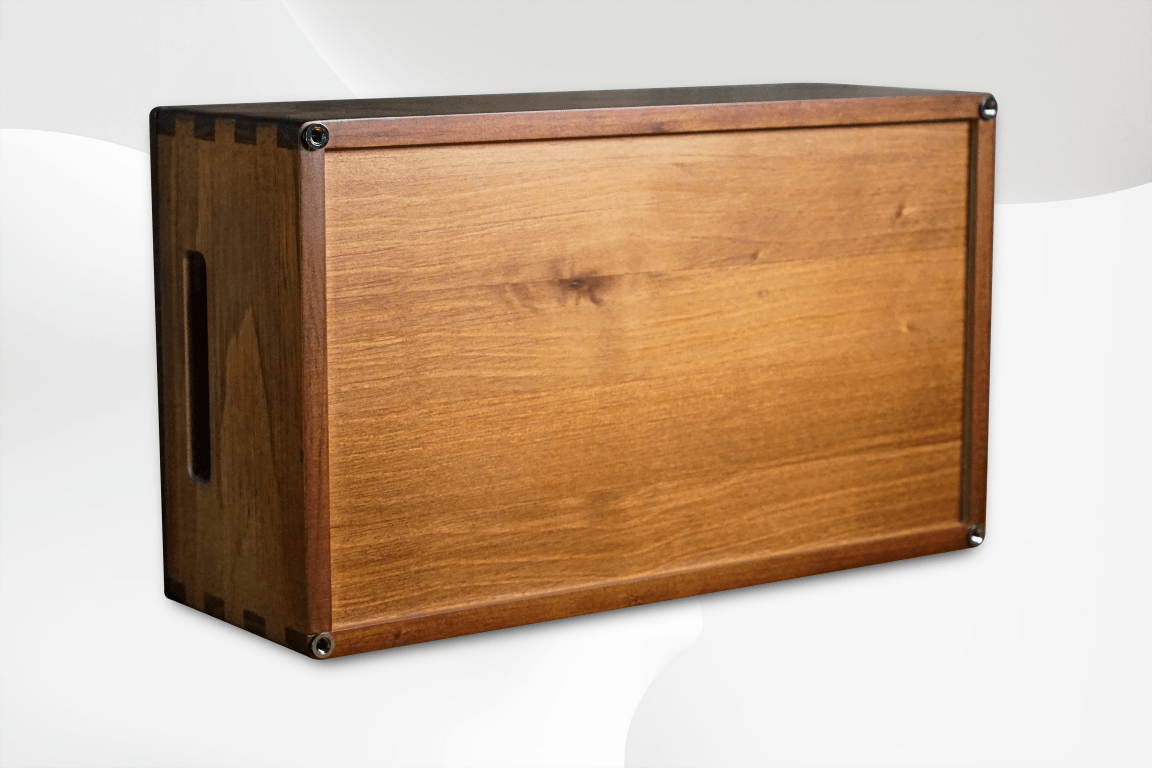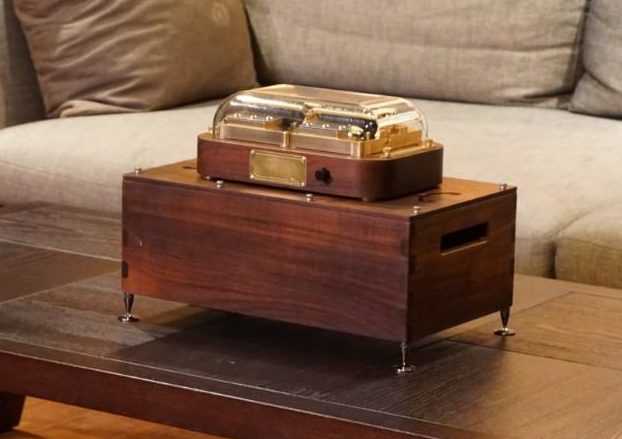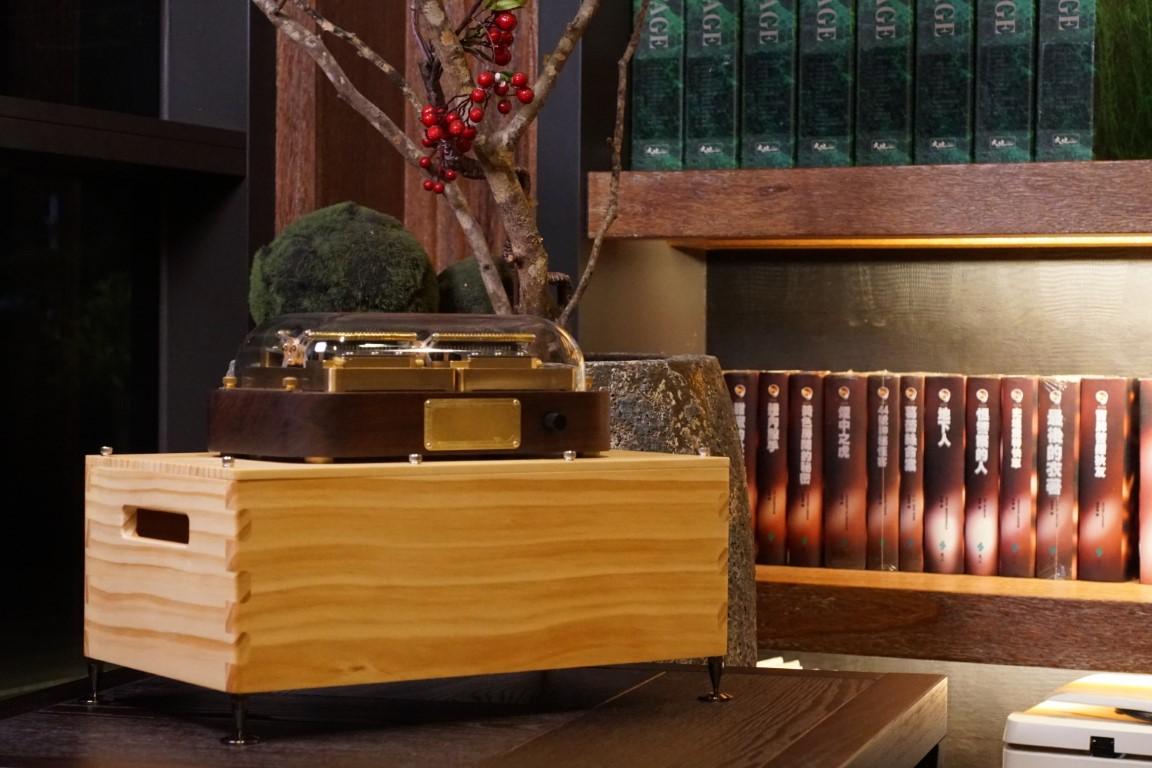Resonance Box for Muro Box-N40
When you purchase a N40 music box, a default pinewood resonance box (unfinished) is included as part of the music box packaging and will be shipped together.
* If you would like to upgrade the default resonance box to a different version, please contact our customer support.
*If you wish to purchase additional resonance boxes of other styles separately, please make your purchase selection on this page.
(Note: The upgrade price for replacing a default resonance box with another style differs from the price of purchasing an N40 resonance box separately.)
Subscribe Newsletter|Discover the Secret Behind Muro Box & Get Special Rewards
Current Production Lead Time: 10 Workdays. Customization services require an additional 3 workdays.
🎁 For urgent custom gifts, order via our site—faster shipping than other platforms.
GLOBAL SHIPPING CHECK HERE!
If you’re located in the United States, please contact our support team directly regarding customs clearance.
Please note: Product prices do not include customs duties. Customers are responsible for any applicable import fees upon delivery.
14 Days Refund & Warranty Policy
Terms of Services
Enjoy a Better Over-All Music Experience
This Resonance Box is dedicated to the Muro Box-N40 model.
It was designed to enrich the details of the sustaining sound effect of Muro Box N40, not just to amplify its volume, because the current volume of Muro Box N40 is loud enough for regular home settings.
Explore the sustain effects of different resonance boxes and find your favorite. Then, choose the resonance box design that best matches the color of your Muro Box N40.

Resonance Box Crafted from Premium Solid Wood
An Auditory and Visual Feast for You
Each piece is crafted from solid wood, with a variety of wood finish options available.
聽看看
N40穆風版/N40標準版,搭配不同材質的共鳴箱的演奏效果!
雞翅木是較硬的木材選項,松木是較軟的木材選項。您可以從影片聽出搭配雞翅木共鳴箱,其尾韻效果越嘹亮且分明;使用松木共鳴箱,其共鳴則較圓潤。
我們選用經典名曲-古老的大鐘,讓您用熟悉的旋律比較音質的差異。錄音全程都在同一直播機的設置環境並以不同機台搭配不同共鳴箱的排列組合,讓您直接比較,找出喜歡的聲音組合!(右方影片待補)
Come and listen!
Experience the performance effects brought by resonance boxes made of different materials.
Millettia Laurentii (Chicken Wing Wood) is a harder wood option, while Pinewood is a softer wood option. From the video, you can hear that the Millettia Laurentii resonance box produces a brighter and clearer sustain, while the Pinewood resonance box creates a rounder, fuller resonance.
We selected the classic piece “The Old Clock” to help you compare the sound quality differences using a familiar melody.
0:00 Muro Box-N40 Sublime + Millettia Laurentii (Chicken Wing Wood) Resonance Box
1:10 Muro Box-N40 Sublime + Pinewood Resonance Box
2:18 Muro Box-N40 Standard Model + Pinewood Resonance Box
3:25 Muro Box-N40 Standard Model + Millettia Laurentii (Chicken Wing Wood) Resonance Box
Compare the Characteristics of Natural Solid Woods
Find Your Favorite
Pinewood
Pinewood has a clean white color, which turns slightly yellow after applying transparent protective varnish. Pinewood is easy to process, the material is readily available, the wood grain is clean, and the color variation is stable. Due to its low hardness, the residual echoes are noticeable. However, traditional music boxes emphasize the vibrational sensation of the bass side’s aftertaste, and the more pronounced residual echo is exactly the characteristic sound when used as a traditional music box.

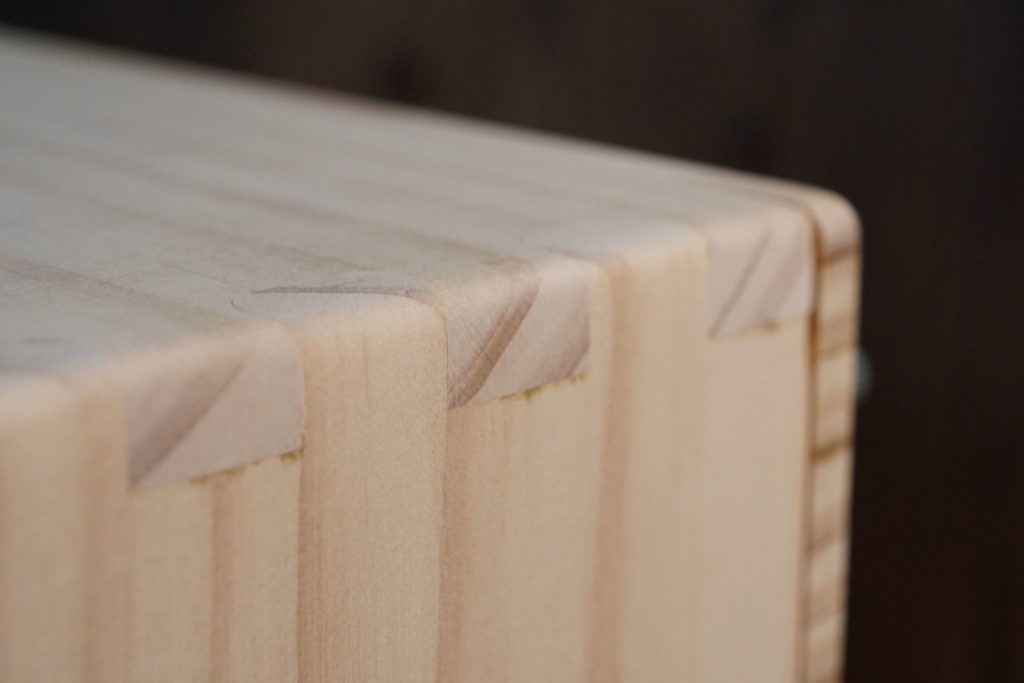
The unfinished Pinewood resonance box is the default version provided with the purchase of the N40 music box, unless you have upgraded to the Pinewood resonance box with clear lacquer finish or the Pinewood resonance box with black walnut lacquer finish, or selected the Millettia Laurentii (Chicken Wing Wood) resonance box for your N40 music box shipment. In those cases, we will ship the N40 with the selected resonance box as per your instructions.




Which Color of the Pinewood Resonance Box Do You Prefer?

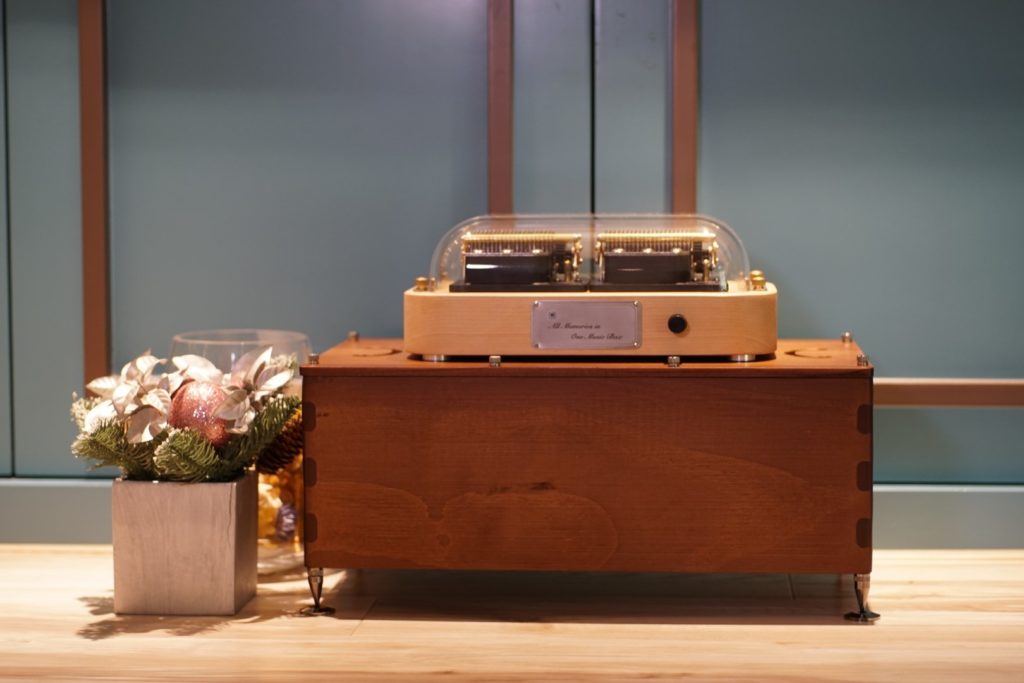
Taiwanese Acacia wood
Taiwanese Acacia wood is a deep coffee color, and due to additional heat treatment, it has the highest hardness of all the woods mentioned. The high notes are solid and clear with each note, but they don’t feel as dry or dull as maple. Instead, they have a pleasant, proper aftertaste.
More importantly, it has a unique caramel aroma, allowing you to almost “smell the taste of music” when you’re close to it. Each Acacia wood resonance box is hand-waxed, avoiding spray painting in order to preserve the unique caramel scent created by the heat treatment.
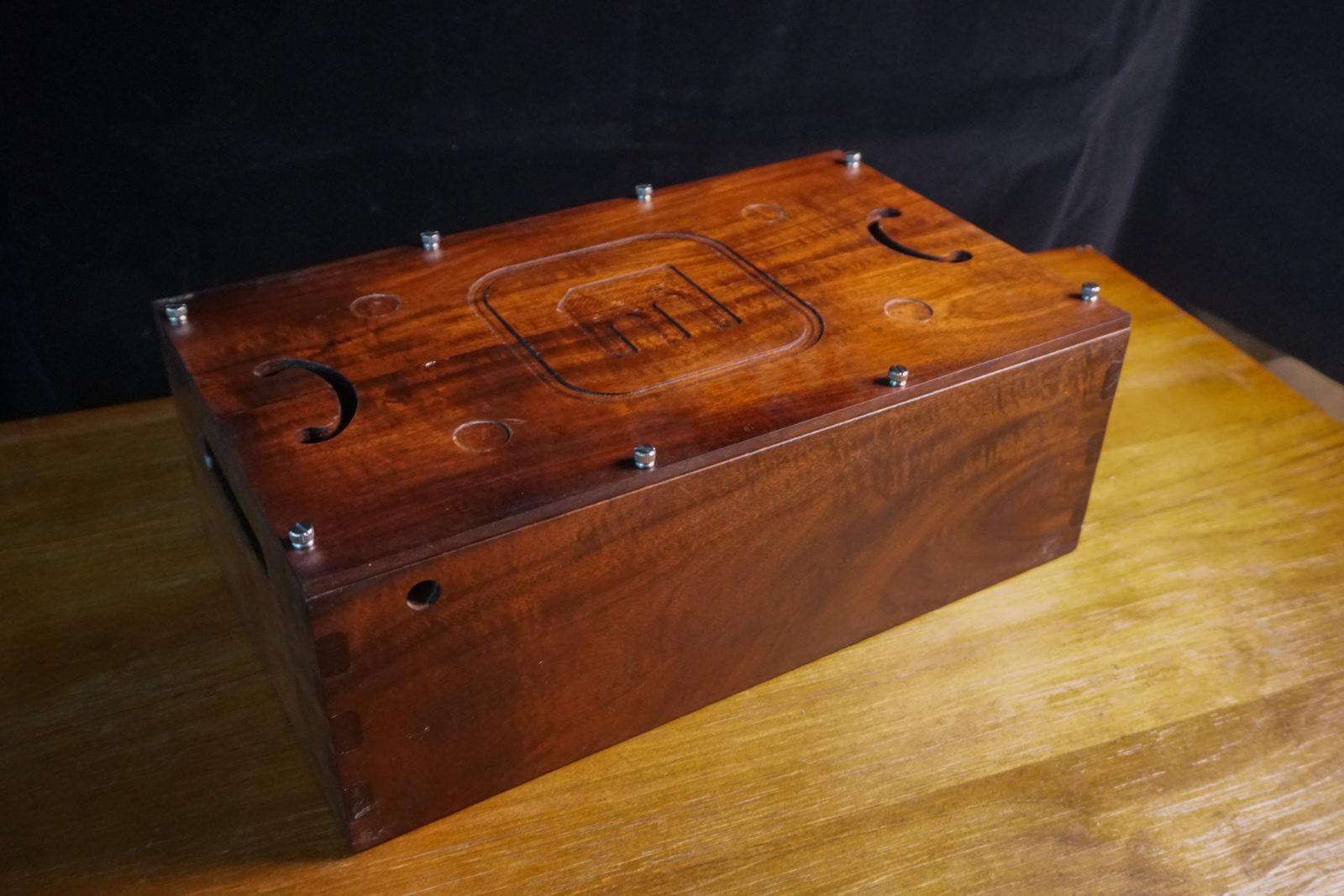

Millettia Laurentii
Millettia Laurentii (its Chinese name means “Chicken wing wood”), as its name suggests, features the most pleasing deep black feather-like wood grain. The sound leans towards cleanliness, but it’s slightly more complex than acacia wood, with additional characteristics reminiscent of the wings of chickens.
The residual echoes in the bass are more pronounced, but it doesn’t feel sticky together like pinewood. Apart from the wood itself lacking any noticeable odor, the sound quality is top-notch. I consider it a reliable choice of wood. However, there is one drawback to the appearance of chicken wing wood: the prominent fibrous texture and occasional small pieces of wood may chip off at the edges.
Please note that this flaw is inherent to the material and unavoidable; we will ship it out as standard quality products.

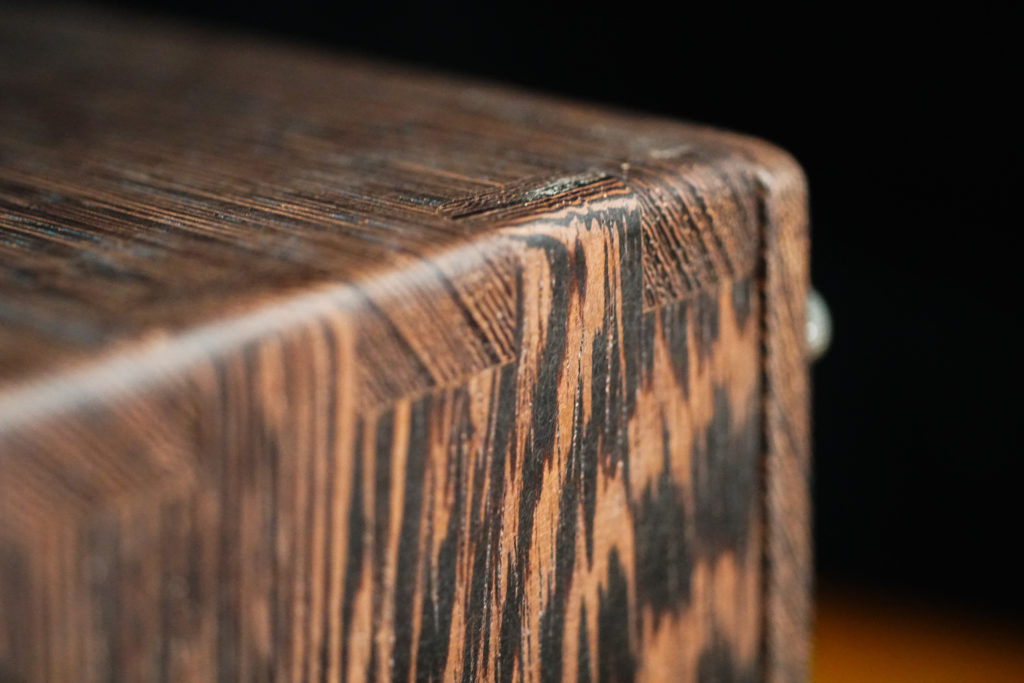
Summary of Insights from Experimenting with Various Resonance Boxes
Here is the evaluation from Muro Box inventor Dr. Chen-Hsiang Feng, comparing the wood characteristics of various resonance boxes based on sound quality and appearance after actual prototyping:
Considering both sound and appearance, Millettia Laurentii > Pinewood. This ranking also corresponds to the order of hardness of the woods themselves. Music boxes are indeed more suitable for resonance boxes made of hardwood.
N40 Resonance Box Assembly Steps

1. Use your fingers or a screwdriver to remove the 8 hand-twist screws.

2. Screw the 4 shock absorbers into the 4 corners’ holes under the resonance box. Place the 4 shock absorbers above their pads to prevent the shock absorber scratching the table surface.
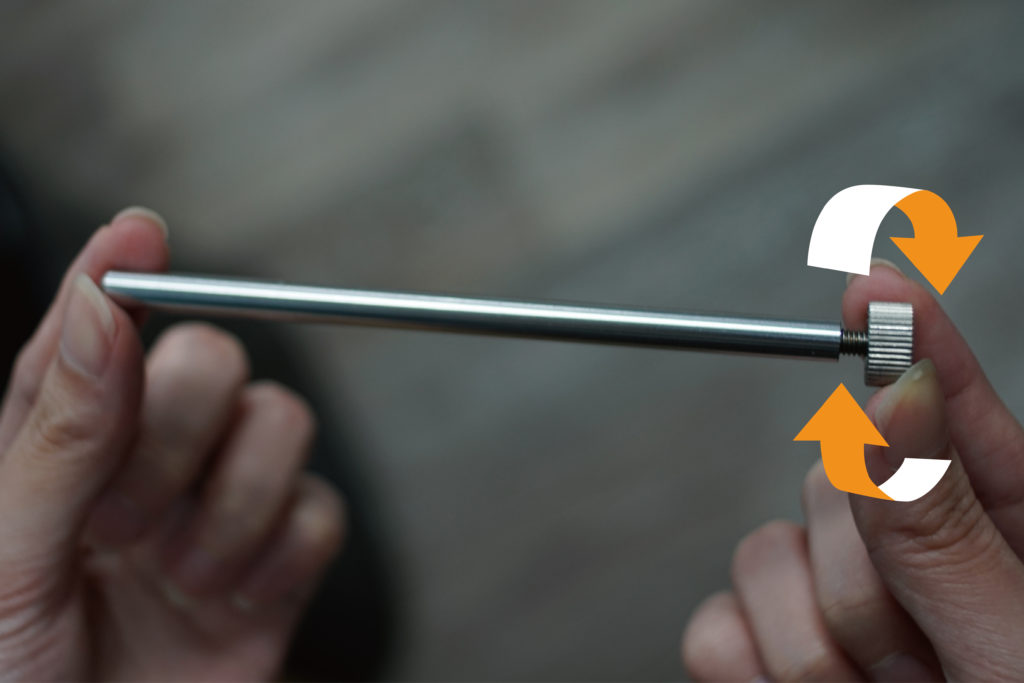
3. Next, place the sound post. Its primary function is to support the weight of the music box on the top board, while also enhancing sound transmission.
First, adjust the sound post to the appropriate length, then check the length against the edge of the resonance box.

The goal is for the sound post to “just” protrude slightly above the resonance box to touch the top board. As long as there is slight contact, it will be effective. Do not extend it too much, as this could cause the top board to crack. Please be careful to control the protrusion to be less than 1mm.
4. The position of the sound post can be placed according to your preference. Place the top board on the resonance box to feel the contact position of the sound post, or confirm the placement of the sound post from the side lifting holes. Then, screw the hand-twisted screws to fasten the top board on the resonance box. Be sure to tighten the hand-twisted screws to avoid noise during music box playback caused by vibration.
5. We’ve left a little fun for you. In addition to placing the sound post in the middle, you can try placing it in other positions to hear the sound effect. Once you find your favorite position, remember to ensure that the hand-twisted screws on the top board are tightened when experimenting with the sound effect.

6. The C-shaped sound hole on the top board of the resonance box is designed based on the principle of violin sound production. The curved square groove of the Muro Box Logo is for securing the bottom feet of a 20-note Muro Box music box, while the four small circular grooves are for fitting the 4 feet of the N40 music box. The two types of grooves allow customers who own both a N20 model and a N40 model of music boxes to interchangeably use this same resonance box for amplified playback effects.
7. Place the four feet of your N40 music box on the four small circles on the music box, plug in the power, and you will hear the default music box melody (a jingle) when the music box is turned on. You can press the knob on the front side to play the preset music box melody, or start pairing it with your Muro Box App to experience the thousands of melodies in our online music library.
You might be curious as to why only two of the four bottom feet of the N40 music box have these soft pads, instead of all four being installed.
The reason is that we need to ensure that two of the wooden feet make direct contact with the resonance box to achieve the best sound transmission effect. Therefore, only two of the bottom feet are equipped with shock-absorbing pads.

The N40-RB resonance box specifications.
Size
Resonance box as an unassembled shipping box
384 x 226 x 173.1 (mm)

Resonance box with installed feet and pads
384 x 226 x 209.2 (mm)

Resonance box with installed feet and pads and music box on top
384 x 226 x 263.6 (mm)

Weight
Pinewood
1422 g

Millettia Laurentii (Chicken wing wood)
2509 g

Pinewood
1422 g

Millettia Laurentii (Chicken wing wood)
2509 g

Native Taiwan Acacia Wood
2611 g

| 5 star | 98 | 98% |
| 4 star | 2 | 2% |
| 3 star | 0% | |
| 2 star | 0% | |
| 1 star | 0% |
1. 雖然不便宜,但質感不錯,又是台灣設計製造,特別想支持一下
2. APP上面有很多其他網友提供的歌曲,很多我都很喜歡,玩起來很有趣
3. 可以訂製我喜歡的歌,當用音樂盒重現出來的時候覺得很感動
4. 建議加入鬧鐘或報時的功能,可以讓音樂盒更實用

Muro Box-N20 Lite 音樂盒適合沒有編曲需求的用家。預載樂曲悅耳,還可以用app下載額外曲目。對純粹想聽音樂的用家已十分足夠。


Murobox is an innovative digital keepsake platform that transforms cherished memories into beautifully curated, tangible experiences like personalized music boxes that play meaningful songs tied to special moments. By thoughtfully integrating technology, design, and emotion, Murobox turns abstract memories into sensory, shareable treasures. The product stands out for its elegance, personalization, and attention to detail, all backed by clear and compassionate communication that truly resonates with users.
非常棒的回憶音樂盒,專屬於我們自己的歌曲,本身就非常喜歡音樂盒的聲音,但是往往只能一首歌,可以隨心所欲切換自己想要的歌曲還能編曲,真是非常棒的設計理念與作品。美中稍嫌一點點不足的部分是,使用手機切換時,音樂有時會發生當機現象,可能需要時間運轉,至少重新開啟能馬上恢復。


Muro Box-N20 不只是音樂盒,更像一台小型留聲機,讓我聯想到萬國戲院裡聲音與影像的連結。它不僅陪伴日常,更能運用在學校教學,把孩子帶進聲音的劇場,讓歷史、文化與創意在課堂中活起來。
Tout simplement magique ! Un produit de qualité qui fonctionne parfaitement bien. La connexion avec l'application est facile. Je n'ai pas réussi à importer un fichier MIDI dans l'application, mais le reste est facile à programmer.
I like it very much. And she like it very much, too.

내가 마음대로 작곡할 수 있는 오르골... 나의 어릴 적 꿈이 이루어졌어요.
很棒的精美禮物 - 我後來改買N40當禮物,非常精美,很有重量感、聲音也很好聽。
The Music Box I’ve Always Dreamed Of - I am a theremin performer and composer.
As the theremin is a monophonic instrument, it often requires accompaniment—typically piano or guitar. However, I’ve always been especially fond of pairing it with music boxes.
Over the years, I’ve explored many types, including disc music boxes and punched-roll models. Yet I continued to long for a high-precision, auto-playing music box that could handle more complex performances.
The Muro Box-N40 turned out to be exactly that. It offers beautiful tone, excellent stability, and precise expression through advanced control. Even real-time performance using a MIDI keyboard is possible, with virtually no latency.
I genuinely believe this is a revolutionary instrument.
In my latest video, I perform Debussy’s Rêverie as a duet with the Muro Box-N40 and theremin. The result was everything I had hoped for.
From now on, I look forward to continuing my musical journey with this remarkable partner.
Amazing Team!!! - I love my Muro Box N20, it works perfectly on its own, with the included phone app, and I can use midi from my external instruments to control it with no problems. As well I got the resonator box, and I can confirm that it is worth it! The music box sounds louder and the sound really fills the whole room. I would highly recommend these music boxes to everyone.
A beautiful music box - The muro box is one of the best creations of modern times. I found out about Muro Box after searching to create a custom music box, but was a taken aback by the cost of creating a custom movement, and the work required to design something beautiful. When I saw Muro Box, I immediately chose it as the product I wanted. Modernized, sleek, and still respects the traditional beauty of mechanical movements. I am very happy with the product.





